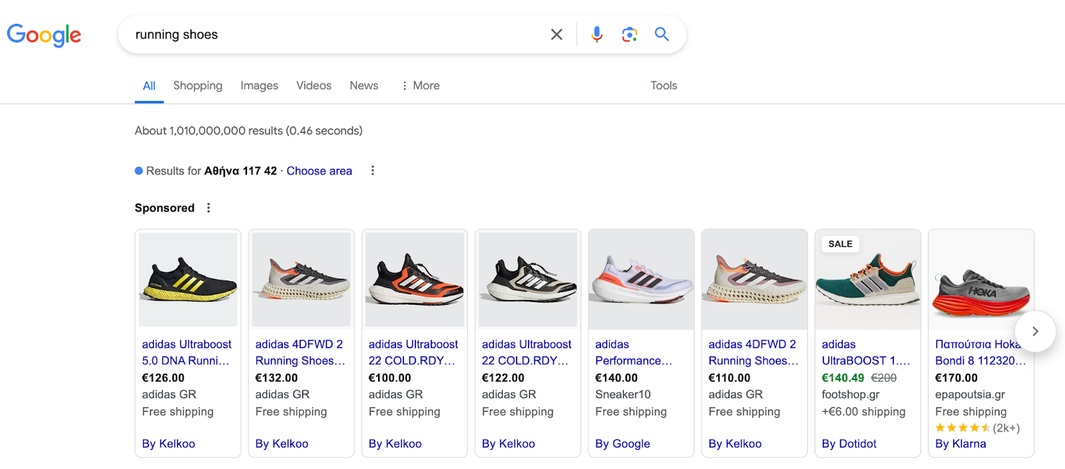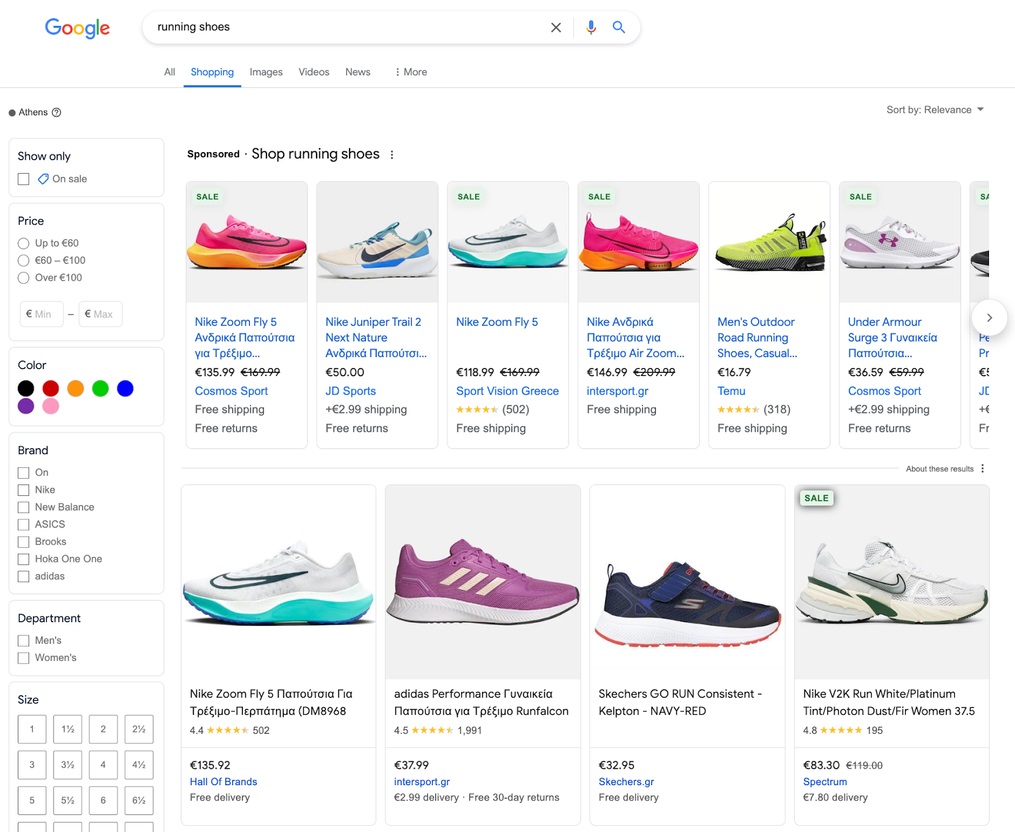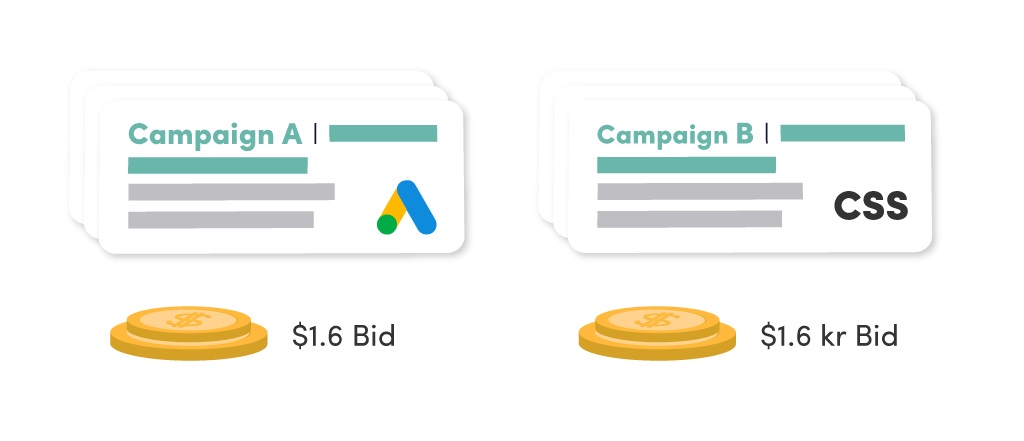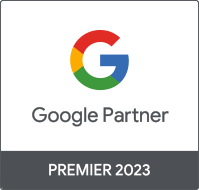The online retail landscape is witnessing a significant shift. Many companies are shifting towards Comparison Shopping Services (CSS) to expand their reach and capture a larger customer base. These platforms offer the enticing prospect of increased product exposure across multiple platforms, alongside the potential for slashing advertising costs by a tempting 20%. However, before you join the CSS bandwagon, let's take a closer look at the realities of this marketing tool and how to leverage it strategically.
What are CSS and how they work
Comparison Shopping Services (CSS) are websites that collect product offers from retailers and place Shopping ads on behalf of merchants in Google's search results. CSS emerged from a ruling in 2015 that required Google to allow other price comparison services to participate in its Shopping ads auction, which was previously dominated by Google Shopping.
Here's an example of a Google Shopping ad placed by Google and Partners CSS:

The main idea behind CSS is to introduce competition and provide merchants with alternative options for advertising their products on Google Shopping, beyond just using Google's own service.
When a user clicks on the "By CSS Partner" link at the bottom of the ad, they are taken to the website of the CSS partner that placed the ad, where they can potentially find more information or purchase the product.
The process works as follows:
Merchants provide their product data feed to a CSS partner of their choice.
The CSS partner optimizes and uploads the product feed to their Merchant Center account registered with Google.
The CSS partner can then bid on product listings and place Shopping ads on Google's search results on behalf of the merchants they represent.
While the ads still direct users to the merchant's website for purchases, the CSS program allows merchants to leverage the expertise and services of third-party price comparison platforms, potentially offering advantages such as reduced costs, better optimization, and additional features.
Sponsored & Organic:

Overall, the CSS program aims to promote competition and provide merchants with more options for advertising their products on Google Shopping, beyond solely relying on Google's own service.
The Enticing Allure of the 20% Discount: A Closer Look
Many CSS providers advertise a seemingly irresistible offer: a substantial reduction in your Google Shopping CPC (cost-per-click). This might sound like a surefire way to boost your bottom line, but the truth is more nuanced.
Here's why achieving the advertised 20% discount consistently is a challenge:
The Theoretical Advantage: The 20% saving isn't a direct discount you receive. Instead, it refers to a potential bidding advantage within the Google Ads auction system. This means your bid might have a stronger influence on ad rank compared to campaigns managed directly by Google Shopping. However, this advantage isn't readily visible or guaranteed.
The Impact of Competition: The effectiveness of the 20% "discount" hinges heavily on the competitive landscape of your niche. If your bids are already significantly higher than your competitors, you might not see a noticeable decrease in CPC, even with a CSS partner. The discount only comes into play when you're bidding against campaigns managed directly by Google Shopping, not against other CSS partners,

Source: https://savvyrevenue.com/blog/css/
Beyond the Myth: The True Value of CSS
While achieving a consistent 20% discount on CPC might be elusive, CSS still offers significant value for online retailers when used strategically:
Brand Awareness Amplification: A Synergy with Google Shopping
While the elusive 20% discount on CPC might not be a guaranteed outcome, there's a significant benefit to using CSS partners in conjunction with Google Shopping: brand awareness amplification. Having your products displayed on multiple shopping engines and marketplaces alongside Google Shopping significantly increases your overall brand visibility. This allows you to reach new customer segments who might not be familiar with your store, potentially attracting them organically over time.
By utilizing both Google Shopping and CSS partners, you create a wider net for potential customers. This can be particularly impactful for new or niche retailers who are trying to establish themselves in the online marketplace.
Leveraging Product Comparisons: CSS platforms present your products alongside competitor offerings in a comparison format. This environment can work to your advantage if your products boast competitive advantages in price, features, or customer reviews. By ensuring your product listings are optimized with high-quality images, compelling descriptions, and accurate information, you can leverage this comparison opportunity to stand out.
Data-Driven Insights: Many CSS platforms provide valuable data and analytics on campaign performance. This data can reveal insights into user behavior, click-through rates, conversion rates, and other metrics. By analyzing this data, you can refine your targeting strategy and optimize your product listings for optimal performance.
Unlocking the Power of CSS: A Strategic Approach
To reap the full benefits of CSS and avoid potential pitfalls, a well-defined strategy is essential. Here are some key considerations for online retailers:
Choosing the Right Partner: Research potential CSS providers and prioritize those with a proven track record, transparent pricing structures, and robust targeting options. Which means, shortlist the ones that you prefer and then make a discussion with them on how they report and track the data of their CSS. Look for providers who offer clear terms of service and excellent customer support.
Optimizing Product Data: High-quality product data is crucial for success on CSS platforms. Ensure your product listings are accurate, complete, and include high-resolution images, compelling descriptions, and competitive pricing. Optimize your product titles with relevant keywords to improve searchability within the CSS platform. Merchant Centre SEO optimisation is key for visibility on CSS platforms, as it ensures your product data is structured and formatted correctly for optimal indexing and ranking on Google Shopping and other CSS partners. This includes optimizing product titles, descriptions, categories, and other attributes with relevant keywords and following best practices for product data feeds.
Campaign Monitoring and Adjustment: Don't set it and forget it! Track your CSS campaigns closely, analyzing metrics like click-through rate (CTR), conversion rate, and cost per acquisition (CPA). Use this data to refine your targeting strategy and optimize your product listings for better performance. Be prepared to adjust your approach based on the data you collect. The campaigns referred to here are Google Shopping campaigns and Performance Max campaigns run through Google Ads, as these are the only campaign types eligible for the CSS (Comparison Shopping Service) program. CSS partners manage these campaigns on behalf of merchants, allowing them to list products on Google Shopping and benefit from reduced cost-per-click (CPC) rates compared to advertising directly on Google.
Advanced Strategies for Maximizing ROI
For online retailers seeking to squeeze the most out of their CSS investment, consider these additional strategies:
Dynamic Pricing: Some CSS platforms allow for dynamic pricing adjustments based on real-time market data, with the use of a third party tool for product feed management like Prisync, Competera, PricingBrain, etc. This can help you stay competitive and potentially improve your conversion rates. By automatically adjusting your prices to reflect competitor pricing and market trends, you can ensure you're offering the most attractive deals without sacrificing profitability.
Feed Management: Investing in a robust feed management solution can streamline the process of keeping your product data across multiple CSS platforms accurate and up-to-date. Manually managing product data across various platforms can be time-consuming and prone to errors. A feed management solution automates the process, ensuring consistency and efficiency. Feed management tools help merchants optimize their product feeds by allowing them to import product catalogs, map data fields, enrich product information, and distribute optimized feeds to various sales channels like Google Shopping, Facebook, and marketplaces. These tools solve key issues like missing data points, incorrect formatting, and channel-specific requirements for product listings. Some top feed management solutions include Channable, Shopping Feed, Lengow, ChannelPilot, Adsmurai, Feed Manager, Beez Up, GoDataFeed, Tradebyte, and Productsup, which offer features like feed creation, optimization, analysis, quality control, and expert support. An ideal feed management tool should provide seamless feed management, data feed creation, performance analysis, feed quality control, expert support, and agency collaboration capabilities.
Retargeting Campaigns: Utilize retargeting campaigns (ideally with Shopping or Performance Max with feed, campaigns) to capture the attention of potential customers who have already interacted with your products on a CSS platform. This can be a powerful way to nudge them towards making a purchase. Retargeting campaigns can be implemented through various channels, such as display advertising or social media advertising. By reminding potential customers about your products after they've shown initial interest, you can increase the likelihood of conversion.
The Takeaway: A Valuable Tool, Not a Magic Bullet
Comparison Shopping Services can be a valuable tool in your online marketing arsenal, but it's crucial to utilize them strategically. While achieving the heavily advertised discounts might not be readily achievable in every scenario, focusing on brand awareness amplification through an integrated digital marketing media plan, targeted customer acquisition, and leveraging product comparisons can significantly enhance your online marketing efforts. By choosing the right partner, optimizing your product data, diligently monitoring your campaigns, and potentially implementing advanced strategies, you can unlock the true power of CSS and achieve your business goals.
Additional Considerations
Hybrid Approach: Some online retailers choose to adopt a hybrid approach, utilizing both Google Shopping and CSS partners. This allows them to leverage the potential bidding advantages of CSS while still benefiting from Google Shopping's features and functionalities.
Long-Term Strategy: Success with CSS requires a long-term perspective. Don't expect immediate results. Be prepared to continually monitor, analyze, and refine your approach to optimize performance over time.
Transparency and Communication: Maintain open communication with your chosen CSS partner. Discuss your goals, expectations, and budget clearly. A reliable CSS partner will work collaboratively with you to develop a strategy that aligns with your business objectives.
By implementing these considerations and leveraging the functionalities of CSS strategically, online retailers can expand their reach, attract new customers, and ultimately achieve their online sales goals.
It is essential to find your partner along this journey, in the eyes of a company with experience and proven performance track record on strategic thinking. Lighthouse is one of them. Get to know us by contacting our team!
References:
https://www.wordstream.com/
https://searchengineland.com/
https://www.3qdept.com/services/ecommerce-marketplaces/
https://brightbid.com/no/blog/why-use-multiple-google-shopping-css/
https://www.channelengine.com/channelengine-vs-channeladvisor
https://savvyrevenue.com/blog/css/


















